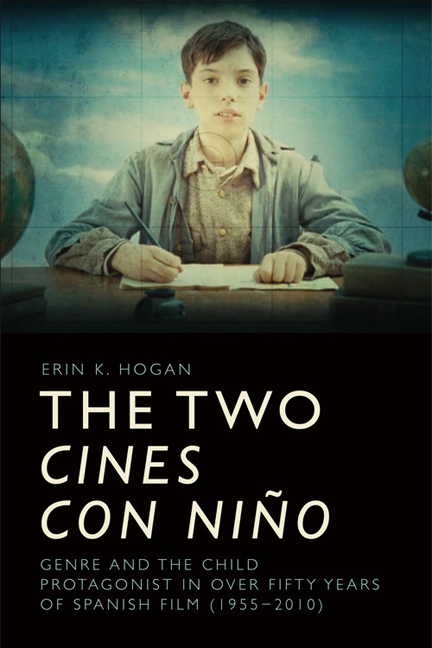Book contents
- Frontmatter
- Contents
- List of Figures
- Acknowledgements
- Figure Permissions
- Introduction The Two Cines Con Niño: The Ventriloquism, Dialogism and Biopolitics of the Children of Franco in Genre Film
- 1 The Black Market and the Stolen Children of Franco in Demonios En El Jardín
- 2 The Appropriative and Carnivalesque Ventriloquism of Altar Boys from Joselito in El pequeño ruiseñor to Ignacio in La mala Educación
- 3 Ventriloquism, Kidnapping and the Carnivalesque in Marisol’s Tómbola
- 4 Adopting, Adapting and Appropriating in the cines con niño: Un rayo de luz and El viaje de Carol
- 5 Prosopopeia and the Gothic Child from Marcelino pan y vino to El Orfanato
- 6 Dialogism and Ritual Function of the Nuevo Cine Con Niño: El Espíritu De La Colmena, Secretos Del Corazón And El Laberinto Del Fauno
- 7 Queering Post-war Childhood in Urte Ilunak and Pa Negre
- 8 The Transatlantic Dialogism in Narrative and Aesthetics of Bildungsfilms: La Lengua De Las Mariposas, Machuca, El Espíritu De La Colmena, El Premio, El Laberinto Del Fauno And Infancia Clandestina
- Conclusion Spanish Movies: Genre, Nation and Spanish Movie
- Select Filmography
- Select Bibliography
- Index
5 - Prosopopeia and the Gothic Child from Marcelino pan y vino to El Orfanato
Published online by Cambridge University Press: 01 May 2021
- Frontmatter
- Contents
- List of Figures
- Acknowledgements
- Figure Permissions
- Introduction The Two Cines Con Niño: The Ventriloquism, Dialogism and Biopolitics of the Children of Franco in Genre Film
- 1 The Black Market and the Stolen Children of Franco in Demonios En El Jardín
- 2 The Appropriative and Carnivalesque Ventriloquism of Altar Boys from Joselito in El pequeño ruiseñor to Ignacio in La mala Educación
- 3 Ventriloquism, Kidnapping and the Carnivalesque in Marisol’s Tómbola
- 4 Adopting, Adapting and Appropriating in the cines con niño: Un rayo de luz and El viaje de Carol
- 5 Prosopopeia and the Gothic Child from Marcelino pan y vino to El Orfanato
- 6 Dialogism and Ritual Function of the Nuevo Cine Con Niño: El Espíritu De La Colmena, Secretos Del Corazón And El Laberinto Del Fauno
- 7 Queering Post-war Childhood in Urte Ilunak and Pa Negre
- 8 The Transatlantic Dialogism in Narrative and Aesthetics of Bildungsfilms: La Lengua De Las Mariposas, Machuca, El Espíritu De La Colmena, El Premio, El Laberinto Del Fauno And Infancia Clandestina
- Conclusion Spanish Movies: Genre, Nation and Spanish Movie
- Select Filmography
- Select Bibliography
- Index
Summary
Introduction
The ventriloquism of the child protagonist that I have discussed thus far has been in the appropriative vein that negates the agency and subjectivity of the child character: from the representation of child appropriation to sexual abuse to abduction by a ventriloquist. In the current chapter, I will explore the liberating and empowering potential of another classification of ventriloquism – prosopopeia – and how it relates to the Gothic child protagonist from Marcelino pan y vino (The Miracle of Marcelino) (Vajda 1955) to El orfanato (The Orphanage) (Bayona 2007). Features in the Gothic mode from the cine con niño to the nuevo cine con niño construct a child protagonist whose sensitivity and marginality allows him or her to empathise with the suffering of other innocents and choose to serve as their advocate. These others may be spirits, ghosts, living dead, or civil dead who have been persecuted with impunity. The Gothic child protagonists engage with the disenfranchised through prosopopeia, which is ‘a form of projection; a form of ventriloquism in which the living speak for or through the dead, just as the adult revisits, reshapes and retells his childhood experiences as if he were (still) a child’ (Lury 2010: 111). This ventriloquial connection to the dead or otherwise maligned is the feature that most interests us in these films. Here we will explore the dialogism of films in the Gothic mode, saving their broader dialogism with regards to rites of passage for Chapter Six. Ann Davies has traced a latent Gothic mode in Spanish cinema whereby:
apparently disparate films are in fact linked together through a Gothic sensibility that threads through them, one that explicitly or tacitly acknowledges Anglo-American concepts of Gothic landscapes and Gothic monstrosity. This then continues through into the 1980s before emerging as full-blown Gothic in the late 1990s and the early twenty-first century. In Spanish cinema before the 1990s we can detect not so much a coherent Gothic genre, but certainly a coherent Gothic mode, ambiguously Spanish, that prefigures the 1990s and beyond. (2016: 117)
For Maria Pramaggiore, the international resonance of these films is due to the child: ‘Spanish horror has succeeded as a global genre embracing Spanish cinema and Spanish language films from other national contexts partly because it uses the child to interrogate the genre's ability to represent traumatic history’ (2017: 71).
- Type
- Chapter
- Information
- The Two cines con niñoGenre and the Child Protagonist in Fifty Years of Spanish Film (1955–2010), pp. 107 - 127Publisher: Edinburgh University PressPrint publication year: 2018



